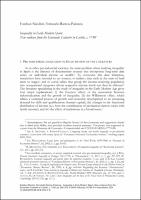Chapter Inequality in Early Modern Spain: New evidence from the Ensenada Cadastre in Castile, c. 1750
| dc.contributor.author | Nicolini, Esteban | |
| dc.contributor.author | Ramos-Palencia, Fernando | |
| dc.date.accessioned | 2022-06-01T12:11:46Z | |
| dc.date.available | 2022-06-01T12:11:46Z | |
| dc.date.issued | 2020 | |
| dc.identifier | ONIX_20220601_9788855180535_217 | |
| dc.identifier.uri | https://library.oapen.org/handle/20.500.12657/56034 | |
| dc.description.abstract | This chapter addresses income inequality by offering new evidence based on the Ensenada Cadastre, a unique database on Castilian households circa 1750. We find that inequality in 18th-century Spain was substantial, especially in urban and/or highly populated areas. There was also a positive – but somewhat weaker – relationship not only between inequality and per capita income but also between inequality and poverty. We posit that extreme economic inequality was likely responsible for numerous episodes of social conflict. Finally, the extent of formalized charity and social spending was less than in other Western European regions. | |
| dc.language | English | |
| dc.relation.ispartofseries | Datini Studies in Economic History | |
| dc.subject.other | economic inequality | |
| dc.subject.other | economic history | |
| dc.subject.other | spanish economic history | |
| dc.subject.other | Iberian peninsula | |
| dc.subject.other | pre-industrial age | |
| dc.title | Chapter Inequality in Early Modern Spain: New evidence from the Ensenada Cadastre in Castile, c. 1750 | |
| dc.type | chapter | |
| oapen.identifier.doi | 10.36253/978-88-5518-053-5.18 | |
| oapen.relation.isPublishedBy | bf65d21a-78e5-4ba2-983a-dbfa90962870 | |
| oapen.relation.isbn | 9788855180535 | |
| oapen.series.number | 1 | |
| oapen.pages | 19 | |
| oapen.place.publication | Florence |

